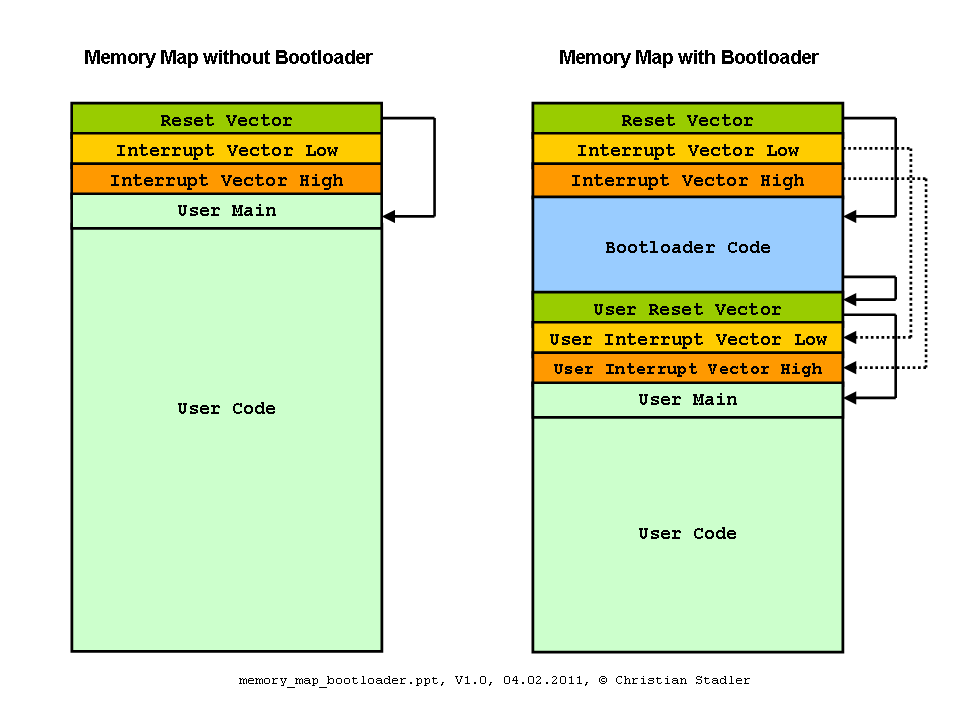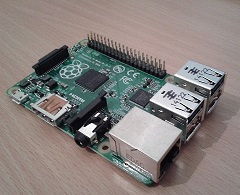Serial PIC Bootloader

- Introduction
- Bootloader Basics
- Hardware
- Bootloader Firmware
- Bootloader Application
- Download
- User Code Relocation
Introduction
What is a bootloader? A bootloader is a small program running in the microcontroller to be programmed. This program allows downloading new firmware to the microcontroller via e.g. a serial interface like RS232 or via USB.
This project shows how to implement a serial bootloader for PIC microcontrollers. The download of the new firmware is done via a RS232 connection. Currently the bootloader only supports PIC18F devices and is written with CCS C compiler (C18 complier support will follow soon).
Bootloader Basics
The bootloader needs to be the first thing which is running after device reset. Hence the bootloader needs to use the reset vector, i.e. the reset vector will point to the start of the bootloader code.
After device reset, the bootloader checks if a new firmware shall be programmed or if the application firmware shall be started. In this example this is done by checking the state of an I/O pin. If the I/O pin is high the bootloader waits for firmware download, if the I/O pin is low, it starts the application firmware.
Further the interrupt vector needs to be remapped. This is necessary because the interrupt service routines will be located at the user code.
Hardware
The bootloader uses the PIC's UART to receive the HEX file to be programmed. The HEX file is sent by by a application program running on the PC.
Before the bootloader can be used, the bootloader firmware must be programmed into the PIC. For that a PIC programmer hardware and corresponding Software is required. This is only required once to get the bootloader code into the PIC. More infos about PIC programmer hardware and software can be found at the PICPgm page.
The PICPgm Bootloader application can be downloaded below. Additionally, the source code can be downloaded below.
Bootloader Firmware
The bootloader firmware is written in C language. Currently only CCS C compiler is suppored, but Microchip C18 compiler support will follow soon.
Bootloader Application
The task of the bootloader application is to send the HEX file to be programmed to the bootloader firmware running in the PIC to be programmed.
Download
- Serial booloader firmware (CCS Compiler): bootloader_firmware_v1001.zip
- Bootloader PC Application: picpgmboot_v1005.zip
- Bootloader PC Application Source: picpgmboot_src_v1005.zip
How to Relocate User Code
Programs which shall be flashed with the bootloader need to be adapted since the bootloader uses the memory area 0x000 to 0x3FF. This area is usually used by the application software itself. So the following changes are required:
- reserve boot block area (0x000-0x3FF)
- map reset vector from 0x000 to 0x400
- map interrupt vector from 0x008/0x018 to 0x408/0x418
How this can be done is depending on the compiler which is used for generation of the HEX file.
MPLAB C18 compiler
For the MPLAB C18 compiler the following changes need to be done:
...
extern void _startup (void); // See c018i.c in your C18 compiler dir
#pragma code _RESET_INTERRUPT_VECTOR = 0x000400
void _reset (void)
{
_asm goto _startup _endasm
}
#pragma code
#pragma code _HIGH_INTERRUPT_VECTOR = 0x000408
void _high_ISR (void)
{
;
}
#pragma code _LOW_INTERRUPT_VECTOR = 0x000418
void _low_ISR (void)
{
;
}
/* This pragma forces the code below this line to be put into the code */
/* section (memory address >= 0x42A). See linker script for details. */
#pragma code
...
Further, a linker script is required to make the application software start at 0x400.
TODO: ADD LINKER SCRIPT EXAMPLE HERE
CCS C Compiler
For the CCS C compiler it is a little bit simpler:
...
/* ------------------------------------------------------------------------- */
/* map reset vector and interrupt vector */
/* 0x000-0x3FF is used by the bootloader. The bootloader maps the original */
/* reset vector (0x000) to 0x400 and the interrupt vector (0x008) to 0x408. */
/* ------------------------------------------------------------------------- */
#build (reset=0x400, interrupt=0x408)
/* ------------------------------------------------------------------------- */
/* reserve boot block area */
/* This memory range is used by the bootloader, so the application must not */
/* use this area. */
/* ------------------------------------------------------------------------- */
#org 0, 0x3FF {}
...
HI-TECH C Compiler
For the HI-TECH C compiler the reset vector can be changed via the compiler option
--CODEOFFSET. For the MCHPUSB bootloader we have to set the option to
--CODEOFFSET=0x0400
If you use the HI-TIDE IDE, the option can be specified in the project properties
(Project => Properties => C/C++ Build => Settings => Advanced => Command Line Options):





